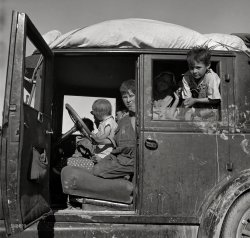
MAY CONTAIN NUTS

Search Shorpy
SHORPY ART

Framed or unframed, desk size to sofa size, printed by us in Arizona and Alabama since 2007. Explore now.
Join and Share
Ad-Free Shorpy
Shorpy is funded by you. Patreon contributors get an ad-free experience.
Learn more.

Recent comments
- Details, Details
- What's that building to the left of the tower?
- Coal Barges
- Bromo-Seltzer
- Inner harbor
- The Basin
- What a headache!
- Giant stepladder?
- Baldwin 62303
- Baldwin VO-1000
- Cold
- No expense spared
- Tough Guys
- Lost in Toyland
- And without gloves
- If I were a blindfolded time traveler
- Smoke Consumer Also Cooks
- Oh that stove!
- Possibly still there?
- What?!?
- $100 Reward
- Freeze Frame
- Texas Flyer wanted
- Just a Year Too Soon
- WWII -- Replacing men with women at the railroad crossing.
- Yes, Icing
- You kids drive me nuts!
- NOT An Easy Job
- I wonder
- Just add window boxes
Member Photos
The Shorpy
Print Emporium
Print Emporium
Search Shorpy
Search results -- 30 results per page
- House of Ill Repute: 1939
- ... 'roping' at window." Photo by Arthur Rothstein for the Farm Security Administration. View full size.
Roping? Definition please. ... Posted by Dave - 04/16/2018 - 7:05am -
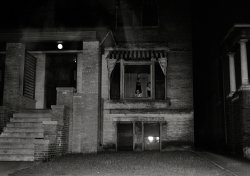
- Dive at Own Risk: 1939
- ... format acetate negative by Marion Post Wolcott for the Farm Security Administration. View full size.
3:15 This photo was taken ... Posted by Dave - 08/03/2019 - 2:33pm -
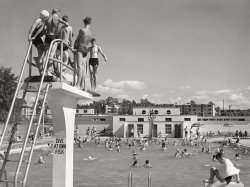
- In-Boxes: 1940
- ... Medium format safety negative by Russell Lee for the Farm Security Administration.
Mailboxes Maybe the Huttons kept a dog in the ... Posted by Dave - 09/05/2012 - 4:13pm -
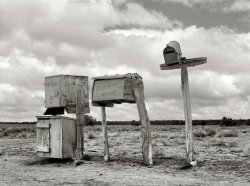
- Bank Shot: 1940
- ... Medium format acetate negative by Russell Lee for the Farm Security Administration. View full size.
Same building? There are a ... Posted by Dave - 08/12/2020 - 2:17pm -
![Bank Shot: 1940 September 1940. "Montrose, Colorado. Old bank." And "Shoeteria." Medium format acetate negative by Russell Lee for the Farm Security Administration. View full size.
Same building?There are a bunch of similarities here but if they are the same there have certainly been some serious alterations done. A matching building from the same architect perhaps? ¯\_(ツ)_/¯
[Wrong intersection! - Dave]
The joys of unit bankingUp until bank deregulation in the mid 1980's, Colorado was a unit banking state, and a very restrictive one at that. Banks coudn't do any business, even back office or IT (computer) functions, in more than one building. This finally resulted in banks having very large buildings like the Wells Fargo one shown here to work in. When Wells Fargo took over First Interstate Bank in 1996, FI only had three banks in Colorado -- Denver, Englewood and Boulder, each previously run separately. Prior to the takeover, Wells only had branches in California. The Englewood FI bank was a massive building for the size of the city, and the First Interstate in Denver had two skyscrapers downtown that stood diagonally opposite each other on a city block, connected by walkways at the corners of various floors to make into "one building". Wells-Fargo must have taken this location over later than 2000, and it would have grown to this size much before then. Don't ask me how I know this!
Those windowsSome beautiful gold leaf on all those windows which banks and their tenants typically employed.
Different BuildingWhere the First National Bank once stood, a Brutalist-tinged Wells Fargo now hulks:
For reference (check the matching notches in the background mountain): Main Street, Montrose, 1939.
(The Gallery, Russell Lee, Small Towns)](https://www.shorpy.com/files/images/SHORPY-8b26216a.thumbnail.jpg)
- Washed Up: 1939
- ... for dinner." 35mm nitrate negative by Russell Lee for the Farm Security Administration. View full size.
The Menu If they were lucky ... Posted by Dave - 05/17/2014 - 10:14pm -
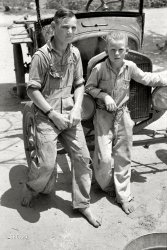
- Delta County Fair: 1940
- ... full size. 35mm Kodachrome transparency by Russell Lee, Farm Security Administration.
Svelte Looking at this picture, I think people ... Posted by Dave - 09/08/2011 - 9:44pm -
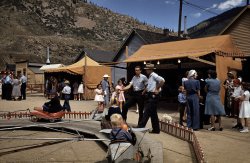
- Grunge Band: 1940
- ... and Pretty. Medium format negative by Russell Lee for the Farm Security Administration. View full size.
This land is your land -- ... Posted by Dave - 07/31/2018 - 11:26am -
![Grunge Band: 1940 June 1940. "Farmer, his wife, and brother in close harmony. Pie Town, New Mexico." Nitty, Gritty and Pretty. Medium format negative by Russell Lee for the Farm Security Administration. View full size.
This land is your land --Woody Guthrie would so enjoy this photo. I wish we could hear it.
Music makingI really love the old photos of people making their own music at home. I kind of wish that was a more common thing in today's world!
This land is your land --I can see Woody Guthrie sitting down and singing along.
Pie TownShorpy has taken us here before. I see there's still no laundromat.
[These people didn't have indoor plumbing or electricity, either. - Dave]
(The Gallery, Music, Pie Town, Russell Lee)](https://www.shorpy.com/files/images/SHORPY-8b25295a.thumbnail.jpg)
- Nue Grocery: 1939
- ... format acetate negative by Marion Post Wolcott for the Farm Security Administration. View full size.
Gone now Both of Joe's ... Posted by Dave - 08/02/2019 - 12:57pm -
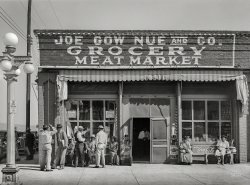
- No More Pencils: 1940
- ... Medium format negative by Arthur Rothstein for the Farm Security Administration. View full size.
Standing strong today In ... Posted by Dave - 02/10/2018 - 2:40pm -
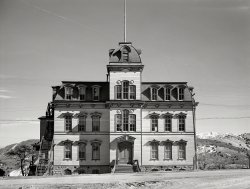
- Grainslinger: 1941
- ... Walla County, Washington." Photo by Russell Lee for the Farm Security Administration. View full size.
The Mystery Man Strikes ... Posted by Dave - 07/12/2020 - 7:09pm -
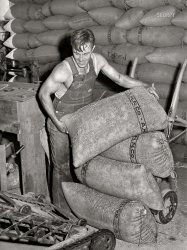
- Chicago Rodeo: 1941
- ... Medium format acetate negative by John Vachon for the Farm Security Administration. View full size.
Little pieces = big ... Posted by Dave - 02/02/2020 - 3:35pm -
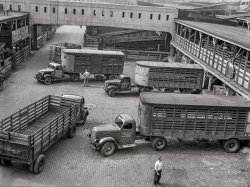
- Larger Than Life: 1939
- ... from Shorpy! Medium format negative by Russell Lee for the Farm Security Administration. View full size.
Four Paws and a Pa Perfect! ... Posted by Dave - 06/16/2018 - 6:17pm -
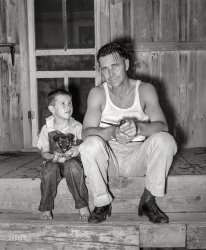
- Grandmother: 1939
- ... October 1939. "Soper grandmother, who lives with family. Farm Security Administration borrower. Willow Creek area. Malheur County, Oregon." ... Posted by Dave - 07/30/2012 - 2:43pm -
![Grandmother: 1939 October 1939. "Soper grandmother, who lives with family. Farm Security Administration borrower. Willow Creek area. Malheur County, Oregon." Medium-format nitrate negative by Dorothea Lange for the FSA. View full size.
Huh?Did they mean super grandmother? If not, what is a soper grandmother?
[She's a member of the Soper family. - Dave]
I live in this areaMy grandparents moved here around that time. I will see if they recognize her. Interesting.
(The Gallery, Dorothea Lange, Portraits)](https://www.shorpy.com/files/images/8b35079u.thumbnail.jpg)
- Two of a Kind: 1941
- ... Park Place." 35mm acetate negative by John Vachon for the Farm Security Administration. View full size.
Fast forward 79 years Many ... Posted by Dave - 09/22/2020 - 3:30pm -
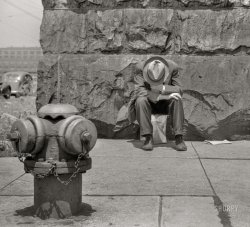
- Pointed Posts: 1940
- ... Medium format negative by Marion Post Wolcott for the Farm Security Administration. View full size.
Simply Amazing that ... Posted by Dave - 01/18/2017 - 10:13am -
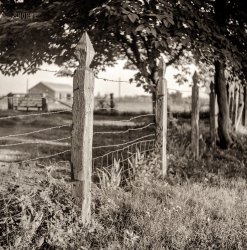
- Our Lady of the Ascension: 1941
- ... Medium format acetate negative by John Vachon for the Farm Security Administration. View full size.
Door stop There’s a ... Posted by Dave - 07/08/2020 - 10:47am -
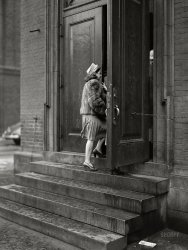
- A Fair to Remember: 1941
- ... Fourth of July." Acetate negative by Russell Lee for the Farm Security Administration. View full size.
Like mother, like daughter ... Posted by Dave - 02/22/2019 - 1:09pm -
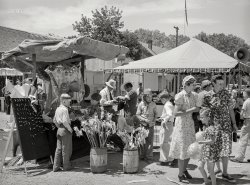
- Freedom Factory: 1941
- ... Medium format acetate negative by John Vachon for the Farm Security Administration. View full size.
Four oil tanks are all that ... Posted by Dave - 08/05/2021 - 11:34pm -
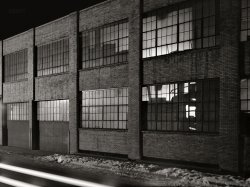
- Silver Place: 1939
- ... Medium format negative by Marion Post Wolcott for the Farm Security Administration. View full size.
Solomon Siler House Here ... Posted by Dave - 04/08/2019 - 9:19pm -
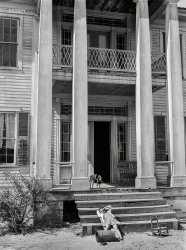
- Glass House: 1941
- ... background." Medium format negative by Jack Delano for the Farm Security Administration. View full size.
A survivor? Probably not ... Posted by Dave - 12/26/2018 - 12:16pm -
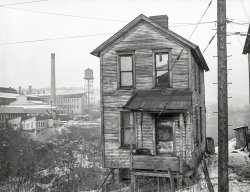
- Sleeps With the Fishes: 1940
- ... market." 35mm nitrate negative by Sheldon Dick for the Farm Security Administration. View full size.
More from Balt Market My ... Posted by Dave - 10/06/2018 - 9:38am -
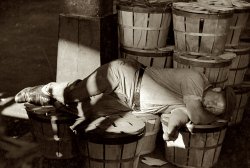
- Near Belle Glade: 1939
- ... Near Belle Glade, Florida." Photo by Marion Post Wolcott, Farm Security Administration. View full size.
Shed Toppers Are the ... Posted by Dave - 04/26/2021 - 5:20pm -
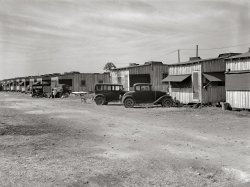
- The Waste Land: 1939
- ... format acetate negative by Marion Post Wolcott for the Farm Security Administration. View full size.
Still appears to be almost a ... Posted by Dave - 05/03/2019 - 11:18am -
![The Waste Land: 1939 September 1939. "Ducktown, Tennessee. Fumes from smelting copper for sulfuric acid have destroyed all vegetation and eroded the land." Medium format acetate negative by Marion Post Wolcott for the Farm Security Administration. View full size.
Still appears to be almost a wastelandThe Verdant hills of Tennessee are marred by a scar in that area, and one of the areas close specifically calls out a tailings retention pond.
So I think this may be the place:
Sorry I'm having a problem embedding a Google Map; maybe Dave can figure out what I can't?
[Click "Share", click "Embed a Map." - Dave]
The land is poisoned, butSomeone took great care to hand-letter that railroad crossing sign with the entirety of pre-automotive verbiage, complete with serifs.
Copperhill smelterThis is one time when Wikipedia really does summarize things well:
https://en.wikipedia.org/wiki/Burra_Burra_Mine_(Tennessee)
The mine itself is located below the marker in RGMBill's image, where there are a couple of small ponds. That's part of the mine's collapse. A larger collapse can be seen closer to the center of Ducktown. The mine buildings were located on the east end of town, the Ducktown Museum building being one of them (with a large mine collapse pond nearby). The name "Citiservices" is also associated with this mine on the map, if you're poking around.
About this picture, though: The smelter was located in Copperhill (formerly McCay), next to the Ocoee River, which is how ore was initially shipped out, and where train lines were built starting in the 1850s. The old smelter site is clearly visible from Google Maps or Earth.
Although copper mining began in the 1840s, the large-scale industrial smelting and sulfuric acid problems probably began in 1899. A good summary is here: https://web.archive.org/web/20120211230436/http://www.gamineral.org/copp...
I could not figure out where the image was taken, but the rail line followed the river north toward Ducktown, passing it on the west and continuing northward through Postelle, TN, skirting the foothills to its west. This would be about two miles west of the lake in RGMBill's image. I suspect the image was taken somewhere near Postelle.
East by NortheastI believe the photographer's vantage point is just northeast of the intersection of Main Street and Hiwassee Street in Ducktown, the camera pointing east-northeast. If this is correct, the barren region pinpointed by our friend RGMBill in the Google image below corresponds to the lighter-valued patch of land seen in the photograph at 2 o'clock from the railroad crossing sign.
I searched through online historic map imagery to locate the snaking rail lines seen in the photograph. Upon discovery of a map showing rail lines that compare favorably with elements of the photograph, it did not take long to formulate my end-of-Main Street theory.
Today, it appears, Main Street ends at or just northeast of Hiwassee Street, but old maps show a road extending from Main Street across the railroad (as seen in the photograph), then down and out into the Ducktown hinterland.
(The Gallery, Landscapes, M.P. Wolcott, Mining, Railroads)](https://www.shorpy.com/files/images/SHORPY-8c10630a2.thumbnail.jpg)
- Grain Train: 1939
- ... Minnesota." Medium format negative by Arthur Rothstein, Farm Security Administration. View full size.
How do they work? I mean ... Posted by Dave - 12/22/2017 - 10:52am -
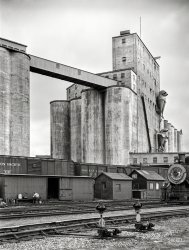
- Fair Beauty: 1940
- ... in Colorado. 35mm Kodachrome transparency by Russell Lee, Farm Security Administration. View full size.
Her Dress That is probably ... Posted by Dave - 09/08/2011 - 9:48pm -
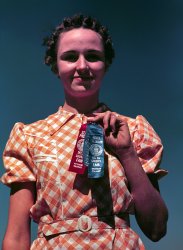
- Pony Show: 1940
- ... West Texas." Medium format negative by Russell Lee for the Farm Security Administration. View full size.
Second choice car There's a ... Posted by Dave - 06/27/2018 - 3:20pm -
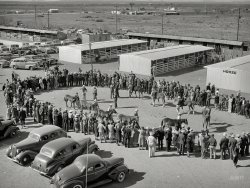
- Well-Read Schoolhouse: 1940
- ... Medium format negative by Marion Post Wolcott for the Farm Security Administration. View full size.
Shoes optional Probably ... Posted by Dave - 06/18/2019 - 1:57pm -
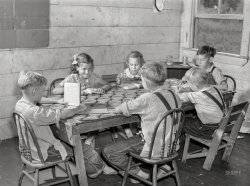
- Pit Rental: 1939
- ... full size. Medium-format negative by Dorothea Lange, Farm Security Administration.
Repair pits In 1926 our family moved into a 6 ... Posted by Dave - 06/27/2008 - 10:10pm -
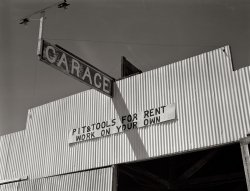
- Got a Light?
- ... Medium-format nitrate negative by Dorothea Lange for the Farm Security Administration.
Curing Time I really love these old tobacco ... Posted by Dave - 01/20/2008 - 2:01am -
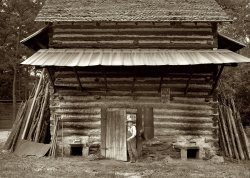
- Migrant Moppets: 1937
- ... on California highway." Photo by Dorothea Lange for the Farm Security Administration. View full size.
I wonder how these folks ... Posted by Dave - 12/26/2013 - 10:49am -
